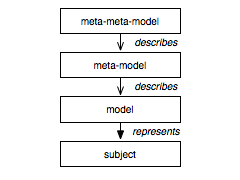Subject, model, meta-model
Defining the vocabulary is important. A while ago, I wrote a small post explaining the terms of subject, model and meta-model. Because they often generate confusion, I am reposting it here for reference.
Before talking about either model or meta-model, we first have to talk about the concept of a subject. A subject is simply something we want to reason about. It can be something from the real world, or something imaginary.
The act of reasoning is typically geared around one specific problem or question. The answer to the question typically only concerns a small subset of all the characteristics of the subject. Thus, the process of reasoning is greatly enhanced if we limit its scope to only the relevant variables.
For example, when we want to reason about the best path to get from point A to point B, we only require the route information, and we do not really need to know about other details like the quantity of oil in the ground, or the language spoken by the inhabitants. This is why for the purpose of route finding, we typically use a travel map which is a great tool that provides exactly the details we need to solve our little problem.
In general, to solve a problem we construct simplifications of the subject. We call these models:
A model is a simplification of the subject, and its purpose is to answer some particular questions aimed towards the subject.
Bezivin, Gerbe
Given that a model captures only a part of the complete subject, we can build many models that represent the same subject but that capture different variables of the subject. To reason about a model we need to know which exact variables it offers. In other words, we need to know the structure of the model. This information is expressed in the meta-model:
A meta-model is a model that makes statements about what can be expressed in valid models.
Ed Siedewitz
One common misconception is to say that a meta-model is the model of a model. That is incorrect. A model shows a simplification of a subject. A meta-model offers the vocabulary for formulating reasonings on top of a given model. While both are models, they are different in intent and interpretation.

Another form of the above misconception is formulated as: the relationship between the model and subject is the same as the one between meta-model and model. That is incorrect as well. While a model represents a subject, a meta-model describes a model.
Once we understand the difference between meta-model and model, we can go even deeper in the meta-land and add as many meta levels as we might need. The picture to the right shows an overall of four levels and their relationships.
Why would we need more meta-levels? We always need a meta-level when we want to reason about the model at the level below. When we want to reason about a map, we need to know its structure. In the same way, when we want to reason about the structure of a map, we need to know the structure of the structure of the map.
Understanding the role of models and meta-models is central to grasping assessment as a whole.
